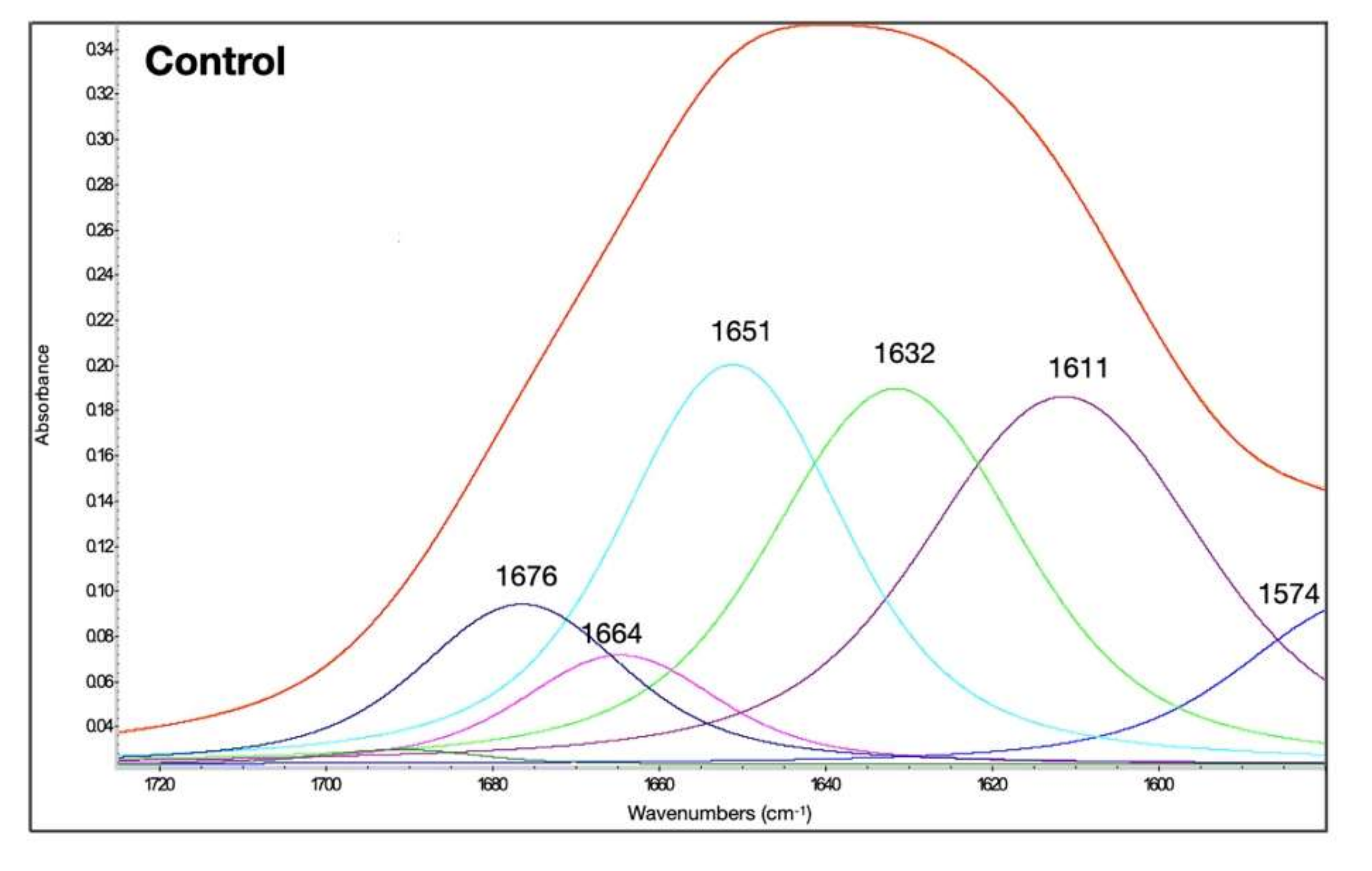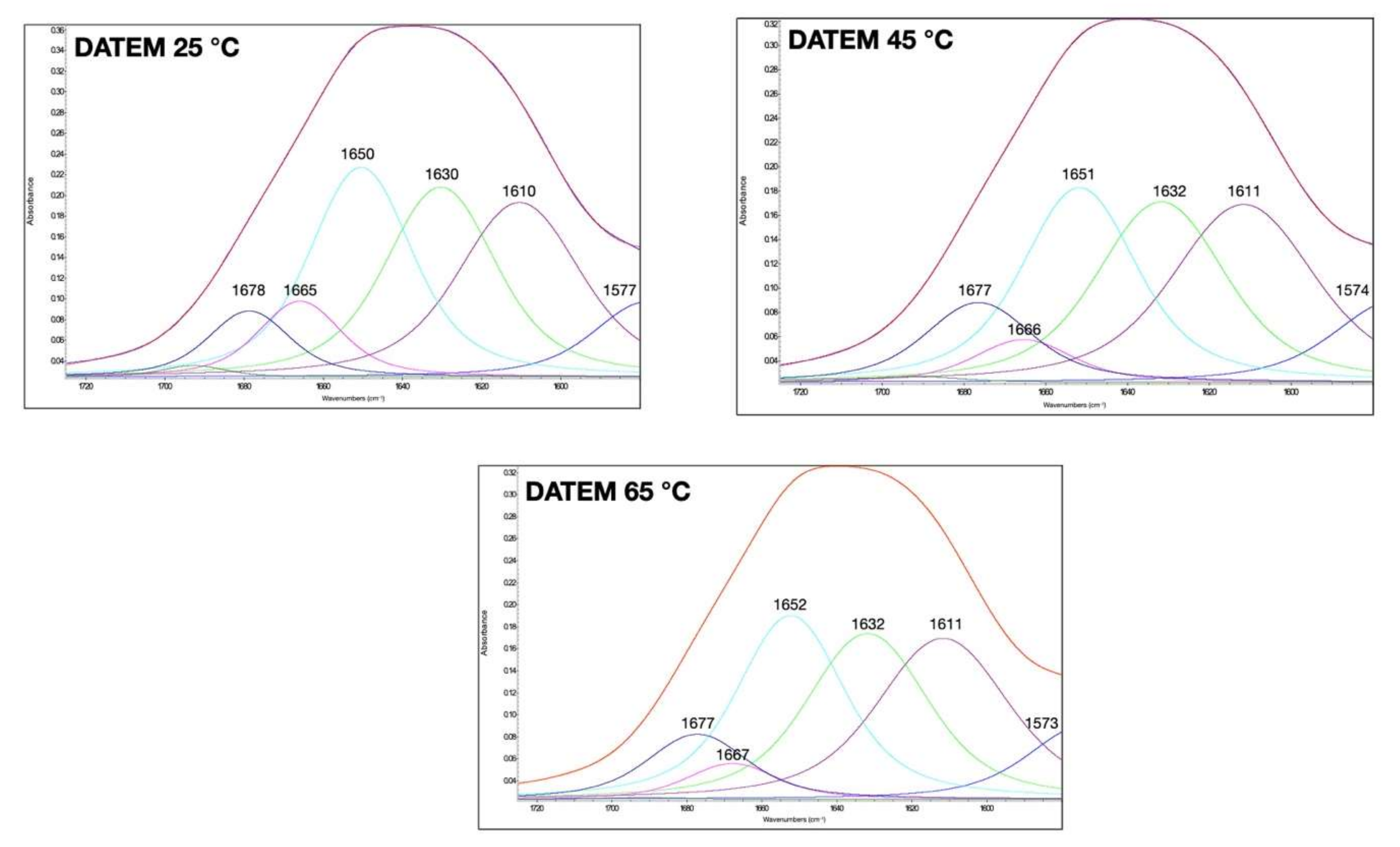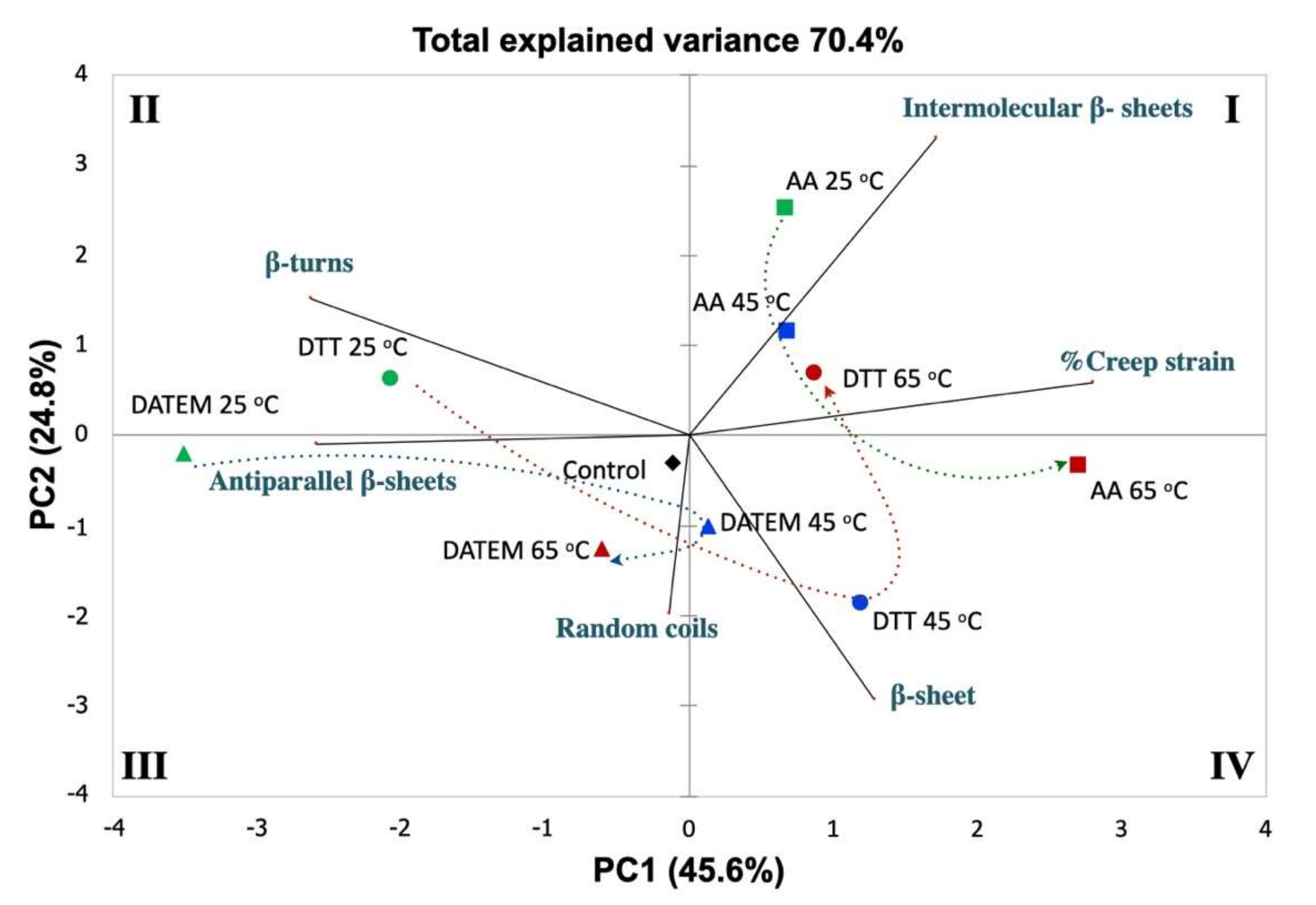Gluten Conformation at Different Temperatures and Additive Treatments
Abstract
:1. Introduction
2. Materials and Methods
2.1. Gluten Preparation
2.2. Creep Test with Temperature
2.3. Fourier Transform Infrared (FTIR) Spectroscopy
2.4. Statistical Analysis
3. Results and Discussion
3.1. Effect of Ascorbic Acid (AA) and Temperature on Gluten Secondary Structural and Viscoelastic Properties
3.2. Effect of DATEM and Temperature on Gluten Secondary Structural and Viscoelastic Properties
3.3. Effect of DTT and Temperature on Gluten Secondary Structural and Viscoelastic Properties
3.4. Effect of Temperature and Additive Treatments on Variation of Secondary Structural Motifs and Viscoelastic Properties
4. Conclusions
Supplementary Materials
Author Contributions
Funding
Institutional Review Board Statement
Informed Consent Statement
Data Availability Statement
Acknowledgments
Conflicts of Interest
References
- Anjum, F.M.; Khan, M.R.; Din, A.; Saeed, M.; Pasha, I.; Arshad, M.U. Wheat gluten: High molecular weight glutenin subunits—Structure, genetics, and relation to dough elasticity. J. Food Sci. 2007, 72, 56–63. [Google Scholar] [CrossRef] [PubMed]
- Belton, P.S. Mini review: On the elasticity of wheat gluten. J. Cereal Sci. 1999, 29, 103–107. [Google Scholar] [CrossRef]
- Edwards, N.M.; Mulvaney, S.J.; Scanlon, M.G.; Dexter, J.E. Role of gluten and its components in determining durum semolina dough viscoelastic properties. Cereal Chem. 2003, 80, 755–763. [Google Scholar] [CrossRef]
- Lindsay, M.P.; Skerritt, J.H. The glutenin macropolymer of wheat flour doughs: Structure–function perspectives. Trends Food Sci. Technol. 1999, 10, 247–253. [Google Scholar] [CrossRef]
- Shewry, P.R.; Halford, N.G. Cereal seed storage proteins: Structures, properties and role in grain utilization. J. Exp. Bot. 2001, 53, 947–958. [Google Scholar] [CrossRef] [Green Version]
- Shewry, P.R.; Halford, N.G.; Belton, P.S.; Tatham, A.S. The structure and properties of gluten: An elastic protein from wheat grain. Philos. Trans. R. Soc. B 2002, 357, 133–142. [Google Scholar] [CrossRef]
- Wieser, H. Chemistry of gluten proteins. Food Microbiol. 2007, 24, 115–119. [Google Scholar] [CrossRef]
- Zaidel, D.N.A.; Chin, N.L.; Yusof, Y.A. A review on rheological properties and measurements of dough and gluten. Res. J. Appl. Sci. 2010, 10, 2478–2490. [Google Scholar]
- Madeka, H.; Kokini, J.L. Changes in rheological properties of gliadin as a function of temperature and moisture: Development of a state diagram. J. Food Eng. 1994, 22, 241–252. [Google Scholar] [CrossRef]
- Tatham, A.S.; Shewry, P.R. The conformation of wheat gluten proteins. The secondary structures and thermal stabilities of α-, β-, γ- and ω-Gliadins. J. Cereal Sci. 1985, 3, 103–113. [Google Scholar] [CrossRef]
- Schofield, J.D.; Bottomley, R.C.; Timms, M.F.; Booth, M.R. The effect of heat on wheat gluten and the involvement of sulphydryl-disulphide interchange reactions. J. Cereal Sci. 1983, 1, 241–253. [Google Scholar] [CrossRef]
- Yada, R.Y. Proteins in Food Processing; Woodhead Publishing: Sawston, UK, 2004; p. 728. [Google Scholar]
- Cauvain, S.P.; Young, L.S. Technology of Breadmaking, 2nd ed.; Springer Science and Bussiness Media, LLC: New York, NY, USA, 2007. [Google Scholar]
- Aamodt, A.; Magnus, E.M.; Ellen, M.F.R. Effect of protein quality, protein content, bran addition, DATEM, proving time, and their interaction on hearth Bread. Cereal Chem. 2004, 81, 722–734. [Google Scholar] [CrossRef]
- Aamodt, A.; Magnus, E.M.; Hollung, K.; Uhlen, A.K.; Færgestad, E.M. Dough and hearth bread characteristics influenced by protein composition, protein content, DATEM, and their interactions. J. Food Sci. 2005, 70, C214–C221. [Google Scholar] [CrossRef]
- Bollaín, C.; Collar, C. Dough viscoelastic response of hydrocolloid/enzyme/surfactant blends assessed by uni- and bi-axial extension measurements. Food Hydrocoll. 2004, 18, 499–507. [Google Scholar] [CrossRef]
- Jacobsberg, F.R.; Worman, S.L.; Daniels, N.W.R. Lipid binding in wheat-flour doughs: The effect of datem emulsifier. J. Sci. Food Agric. 1976, 27, 1064–1070. [Google Scholar] [CrossRef]
- Chompoorat, P.; Ambardekar, A.; Mulvaney, S.; Rayas-Duarte, P. Rheological characteristics of gluten after modified by DATEM, ascorbic acid, urea and DTT using creep-recovery test. J. Mod. Phys. 2013, 4, 38732. [Google Scholar] [CrossRef] [Green Version]
- Van Velzen, E.J.; van Duynhoven, J.P.; Pudney, P.; Weegels, P.L.; van der Maas, J.H. Factors associated with dough stickiness as sensed by attenuated total reflectance infrared spectroscopy. Cereal Chem. 2003, 80, 378. [Google Scholar] [CrossRef]
- Wellner, N.; Mills, E.N.C.; Brownsey, G.; Wilson, R.H.; Brown, N.; Freeman, J.; Halford, N.G.; Shewry, P.R.; Belton, P.S. Changes in protein secondary structure during gluten deformation studied by dynamic fourier transform infrared spectroscopy. Biomacromolecules 2004, 6, 255–261. [Google Scholar] [CrossRef]
- Xiang, S.; Zou, H.; Liu, Y.; Ruan, R. Effects of microwave heating on the protein structure, digestion properties and maillard products of gluten. J. Food Sci. Technol. 2020, 57, 2139–2149. [Google Scholar] [CrossRef]
- Verbauwhede, A.E.; Lambrecht, M.A.; Fierens, E.; Hermans, S.; Shegay, O.; Brijs, K.; Delcour, J.A. Thermo-reversible inhibition makes aqualysin 1 from Thermus aquaticus a potent tool for studying the contribution of the wheat gluten network to the crumb texture of fresh bread. Food Chem. 2018, 264, 118–125. [Google Scholar] [CrossRef]
- Zhang, J.; Luo, D.; Xiang, J.; Xu, W.; Xu, B.; Li, P.; Huang, J. Structural variations of wheat proteins under ultrasound treatment. J. Cereal Sci. 2021, 340, 127903–127913. [Google Scholar] [CrossRef]
- Georget, D.M.R.; Belton, P.S. Effects of temperature and water content on the secondary structure of wheat gluten studied by FTIR Spectroscopy. Biomacromolecules 2006, 7, 469–475. [Google Scholar] [CrossRef] [PubMed]
- Kong, J.; Yu, S. Fourier Transform Infrared Spectroscopic analysis of protein secondary structures. Acta Biochim. Biophys. Sin. 2007, 39, 549–559. [Google Scholar] [CrossRef] [PubMed] [Green Version]
- Cauvain, S.P. Bread Making: Improving Quality; Woodhead Publishing Ltd.: Abington Hall, UK, 2003. [Google Scholar]
- Ponzio, N.R.; Ferrero, C.; Puppo, M.C. Wheat varietal flours: Influence of pectin and DATEM on dough and bread quality. Int. J. Food Prop. 2011, 16, 33–44. [Google Scholar] [CrossRef]
- Zhao, L.; Wang, K.; Zhu, J.; Guo, J.; Hu, Z. Temperature-induced interaction with carboxymethyl cellulose affected the rheological properties and structure of wheat gluten. LWT Food Sci. Technol. 2020, 133, 109993–110001. [Google Scholar] [CrossRef]
- Eckert, B.; Amend, T.; Belitz, H.-D. The course of the SDS and Zeleny sedimentation tests for gluten quality and related phenomena studied using the light microscope. Z. Lebensm. Unters. Forsch. 1993, 196, 122–125. [Google Scholar] [CrossRef]
- Hayta, M.; Schofield, J.D. Dynamic rheological behavior of wheat glutens during heating. J. Sci. Food Agric. 2005, 85, 1992–1998. [Google Scholar] [CrossRef]
- Xiao, F.; Zhang, X.; Niu, M.; Xiang, X.; Chang, Y.; Zhao, Z.; Xiong, L.; Zhao, S.; Rong, J.; Tang, C.; et al. Gluten development and water distribution in bread dough influenced by bran components and glucose oxidase. LWT Food Sci. Technol. 2021, 137, 110427–110437. [Google Scholar] [CrossRef]
- Khatkar, B.S. Dynamic rheological properties and bread-making qualities of wheat gluten: Effects of urea and dithiothreitol. J. Sci. Food Agric. 2005, 85, 337–341. [Google Scholar] [CrossRef]
- Gómez, A.V.; Ferrer, E.G.; Añón, M.C.; Puppo, M.C. Changes in secondary structure of gluten proteins due to emulsifiers. J. Mol. Struct. 2013, 1033, 51–58. [Google Scholar] [CrossRef]
- Wang, J.J.; Yang, J.; Wang, Y.; Zheng, H.; Tian, Z.; Zhang, Y.; Ou, S.; Hu, S.Q.; Chen, L. Heat and edible salts induced aggregation of the N-terminal domain of HMW 1Dx5 and its effects on the interfacial properties. Food Hydrocoll. 2018, 82, 388–398. [Google Scholar] [CrossRef]
- Mejri, M.; Rogé, B.; BenSouissi, A.; Michels, F.; Mathlouthi, M. Effects of some additives on wheat gluten solubility: A structural approach. Food Chem. 2005, 92, 7–15. [Google Scholar] [CrossRef]
- Bock, J.E.; Connelly, R.K.; Damodaran, S. Impact of bran addition on water properties and gluten secondary structure in wheat flour doughs studied by attenuated total reflectance Fourier transform infrared spectroscopy. Cereal Chem. 2013, 90, 377–386. [Google Scholar] [CrossRef]





| Treatment | Area (%) | Creep Strain (%) | ||||
|---|---|---|---|---|---|---|
| Intermolecular β-Sheets/ Extended Hydrated Chains | Antiparallel β-Sheets, More Weakly Hydrogen-Bonded β-Sheets | Random Coils and α-Helices | β-Turns | β-Sheets | ||
| Control | 26.4 f | 24.3 d | 23.5 e | 5.6 b | 8.7 c | 13.4 d |
| AA 25 °C | 29.5 a | 24.3 de | 22.3 g | 5.3 b | 7.3 h | 13.9 c |
| AA 45 °C | 28.9 b | 24.2 f | 24.0 cd | 4.6 c | 7.6 g | 12.2 f |
| AA 65 °C | 27.9 c | 23.8 g | 25.7 a | 3.1 e | 8.2 e | 19.1 a |
| DATEM 25 °C | 25.5 h | 25.0 b | 25.7 ab | 7.5 a | 6.5 j | 7.1 i |
| DATEM 45 °C | 26.5 f | 24.3 e | 23.8 de | 4.4 cd | 9.2 b | 11.0 g |
| DATEM 65 °C | 26.3 g | 24.9 c | 25.2 b | 4.1 d | 8.3 d | 11.0 g |
| DTT 25 °C | 27.1 e | 25.6 a | 22.9 f | 5.6 b | 7.8 f | 9.5 h |
| DTT 45 °C | 26.4 f | 24.2 f | 23.8 de | 3.4 e | 10.4 a | 12.4 e |
| DTT 65 °C | 27.5 d | 23.8 g | 24.5 c | 4.8 c | 7.1 i | 15.0 b |
| Intermolecular β-Sheets/Extended Hydrated Chains | Antiparallel β-Sheets, More Weakly Hydrogen-Bonded β-Sheets | Random Coils and α-Helices | β-Turns | β-Sheet | Creep Strain (%) | |
|---|---|---|---|---|---|---|
| Intermolecular β- sheets | 1.000 | |||||
| Antiparallel β-sheets | −0.400 | 1.000 | ||||
| Random coils | −0.438 | −0.158 | 1.000 | |||
| β-turns | −0.262 | 0.540 | −0.063 | 1.000 | ||
| β-sheet | −0.267 | −0.200 | −0.178 | −0.657 * | 1.000 | |
| Creep strain | 0.547 | −0.770 * | 0.060 | −0.670 * | 0.149 | 1.000 |
Publisher’s Note: MDPI stays neutral with regard to jurisdictional claims in published maps and institutional affiliations. |
© 2022 by the authors. Licensee MDPI, Basel, Switzerland. This article is an open access article distributed under the terms and conditions of the Creative Commons Attribution (CC BY) license (https://creativecommons.org/licenses/by/4.0/).
Share and Cite
Chompoorat, P.; Fasasi, A.; Lavine, B.K.; Rayas-Duarte, P. Gluten Conformation at Different Temperatures and Additive Treatments. Foods 2022, 11, 430. https://doi.org/10.3390/foods11030430
Chompoorat P, Fasasi A, Lavine BK, Rayas-Duarte P. Gluten Conformation at Different Temperatures and Additive Treatments. Foods. 2022; 11(3):430. https://doi.org/10.3390/foods11030430
Chicago/Turabian StyleChompoorat, Pavalee, Ayuba Fasasi, Barry K. Lavine, and Patricia Rayas-Duarte. 2022. "Gluten Conformation at Different Temperatures and Additive Treatments" Foods 11, no. 3: 430. https://doi.org/10.3390/foods11030430
APA StyleChompoorat, P., Fasasi, A., Lavine, B. K., & Rayas-Duarte, P. (2022). Gluten Conformation at Different Temperatures and Additive Treatments. Foods, 11(3), 430. https://doi.org/10.3390/foods11030430







